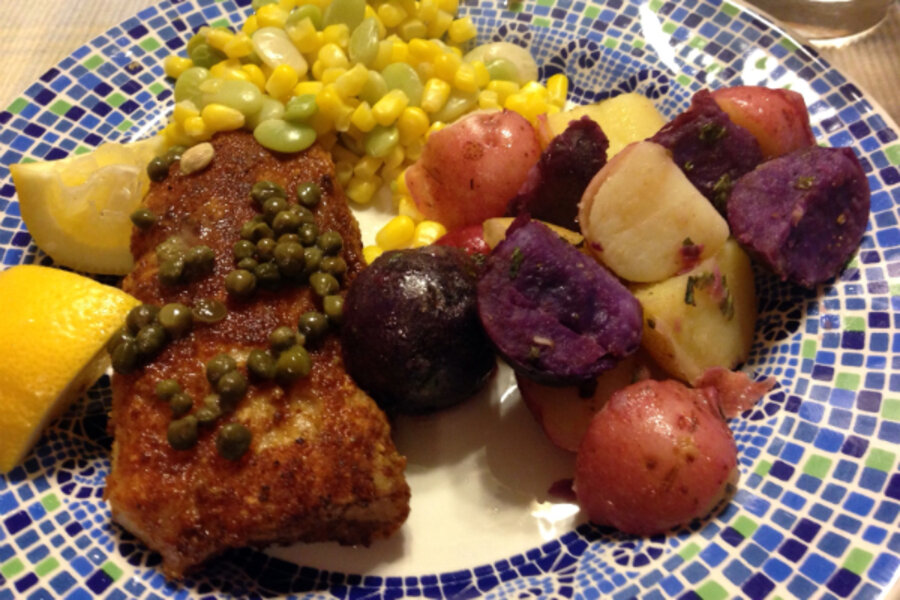Julia Child's sole meuniere
Loading...
In the webinar I am currently teaching "An American culinary journey: From succotash to urban chickens," we are spending an entire section on Julia Child.
In many ways Julia's own journey (and I feel like I can be on a first name basis here, since her genius lay in her ability to be accessible and engaging) epitomizes the transition of American cuisine – from one that was recovering from war rations and Jell-O molds into the discovery of cuisine, food as an element able to delight the senses, engage the mind, and empower a cook to exude creativity.
Her own awakening, as it is widely known, came in Rouen, France with sole meunière.
Paul and Julia Child, who had both worked for the Office of Strategic Services, moved to Paris when Paul accepted a job as an exhibits officer with the United States Information Agency.
Paul, who was an artist, poet, and photographer, had the more sophisticated palate of the couple and it was he who introduced Julia to French cuisine in a way that opened her eyes to the notion that food could be a form of high art. In her book, “My Life in France,” which she co-authored with her nephew, Alex Prud'Homme, Julia describes experiencing true French cuisine for the first time when she and Paul arrived in Rouen, France:
“Rouen is famous for its duck dishes, but after consulting the waiter Paul had decided to order sole meunière. It arrived whole: a large, flat Dover sole that was perfectly browned in a sputtering butter sauce with a sprinkling of chopped parsley on top. The waiter carefully placed the platter in front of us, stepped back, and said: ‘Bon appetit!’
“I closed my eyes and inhaled the rising perfume. Then I lifted a forkful of fish to my mouth, took a bite, and chewed slowly. The flesh of the sole was delicate, with a light but distinct taste of the ocean that blended marvelously with the browned butter. I chewed slowly and swallowed. It was a morsel of perfection.”
To the best of my knowledge, I've never had sole meunière – at least one that I remembered like that. It seemed important in my own education of Julia Child's path to recreate this life-changing dish. As she later put it, "That lunch in Rouen.... It was the most exciting meal of my life."
With this much weight on one dish, I was a little intimidated that I would be able to do it justice. I also wanted to try it in the blur of a weeknight, since the instructions in Julia's cookbook "The Way to Cook," indicated that it could be put together in literally minutes.
At my corner market there was no sole, but there was a nice piece of local cod, which doesn't turn up too often because of heavy fishing regulations. I set out several aluminum pie tins to flour and bread the fish (Julia says she keeps several on hand for this kind of thing) and pulled out my homemade breadcrumbs from the freezer. I decided to steam colorful baby potatoes and heat up frozen succotash I had on hand to go along with it.
I clarified some unsalted butter (also known as ghee), Julia recommends this, and it only takes minutes. Simply heat tablespoons of butter in a saucepan until it boils, and let it boil away until it stops crackling. The point here is to get rid of excess moisture in order to deepen the buttery flavor. Once it has stopped crackling, pour the melted butter through a tea strainer or cheese cloth into a ramekin. Clarified butter will keep for several months in the refrigerator.
I also took the extra step in breading the fish, which isn't called for in the recipe but is another suggested step in "The Way to Cook." To do this, after you dip the filets in flour, shake off the excess and then quickly dip into an egg beaten with a little oil, and then into about a 1/2 cup of breadcrumbs. Be sure to add the coating only moments before you are going to add the filets to the pan, or the breading will get mushy. I forgot to pick up fresh parsley, but I decided to try capers. Up to this point, I haven't really cared for capers. This dish changed my mind.
One or 2 minutes on each side, and my sole (cod) meunière was ready. I took a bite – wow. The hurried pace of my day slowed down and I focused in right where I was. Buttery and light, the crispy outer layer gave way to a delicate fish that was, for once, not overcooked. If I could be impressed by sole meunière in a tiny Boston apartment at my first attempt, I can only glimpse what Julia must have experienced all those years ago during an afternoon in Rouen.
Sole meunière
From "The Way to Cook," by Julia Child
4 to 6 skinless, boneless filets of sole
1/2 cup flour
5 to 6 tablespoons of clarified butter
Fresh parsley, chopped
Lemon wedges
Salt and pepper, to taste
2 tablespoons capers (optional)
1. Layout and pat dry the fillets. Season with salt and pepper.
2. Dredge in a light coating of flour, brushing off excess with your fingers.
3. In a skillet on medium-high heat, pour in clarified butter and heat until just before browning.
4. Place filets in the pan, without overcrowding, about 3 to 4 a skillet. Brown on one side about 1 to 2 minutes, and carefully flip over to brown the other side.
5. Remove fish to platter, and if using, add capers to butter and heat for a minute. Pour capers and butter over fish.
6. Garnish with lemon and fresh parsley. Serve.






